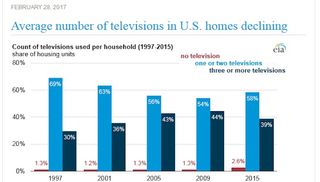Department of Energy: TV Ownership Declines From 2009

The average number of TVs in homes is on the decline, according to the Department of Energy's U.S. Energy Information Administration's most recent figures, while younger households have higher concentrations of broadband-content access devices.
According to its latest Residential Energy Consumption Survey, there are an average of 2.3 TVs per home in 2015, down from 2.6 in 2009.
In addition, a larger share of homes reported not using a TV set at all. In fact, the percentage doubled from 1.3% in 2009 to 2.6% in 2015.
The survey found that "younger households tend to have a lower concentration of televisions per person and a higher concentration of portable devices such as laptops and smart phones. Older households are more likely to have higher concentrations of desktop computers."
According to DOE, TVs, cable boxes, DVRs and video game consoles account for 6% of all residential electricity consumption in the U.S. (Editor's note: The story initially said it was 6% of all electricity consumption. We regret the error.)
The survey looked at more than 200 energy-related items from more than 5,600 households.
Broadcasting & Cable Newsletter
The smarter way to stay on top of broadcasting and cable industry. Sign up below
Contributing editor John Eggerton has been an editor and/or writer on media regulation, legislation and policy for over four decades, including covering the FCC, FTC, Congress, the major media trade associations, and the federal courts. In addition to Multichannel News and Broadcasting + Cable, his work has appeared in Radio World, TV Technology, TV Fax, This Week in Consumer Electronics, Variety and the Encyclopedia Britannica.

